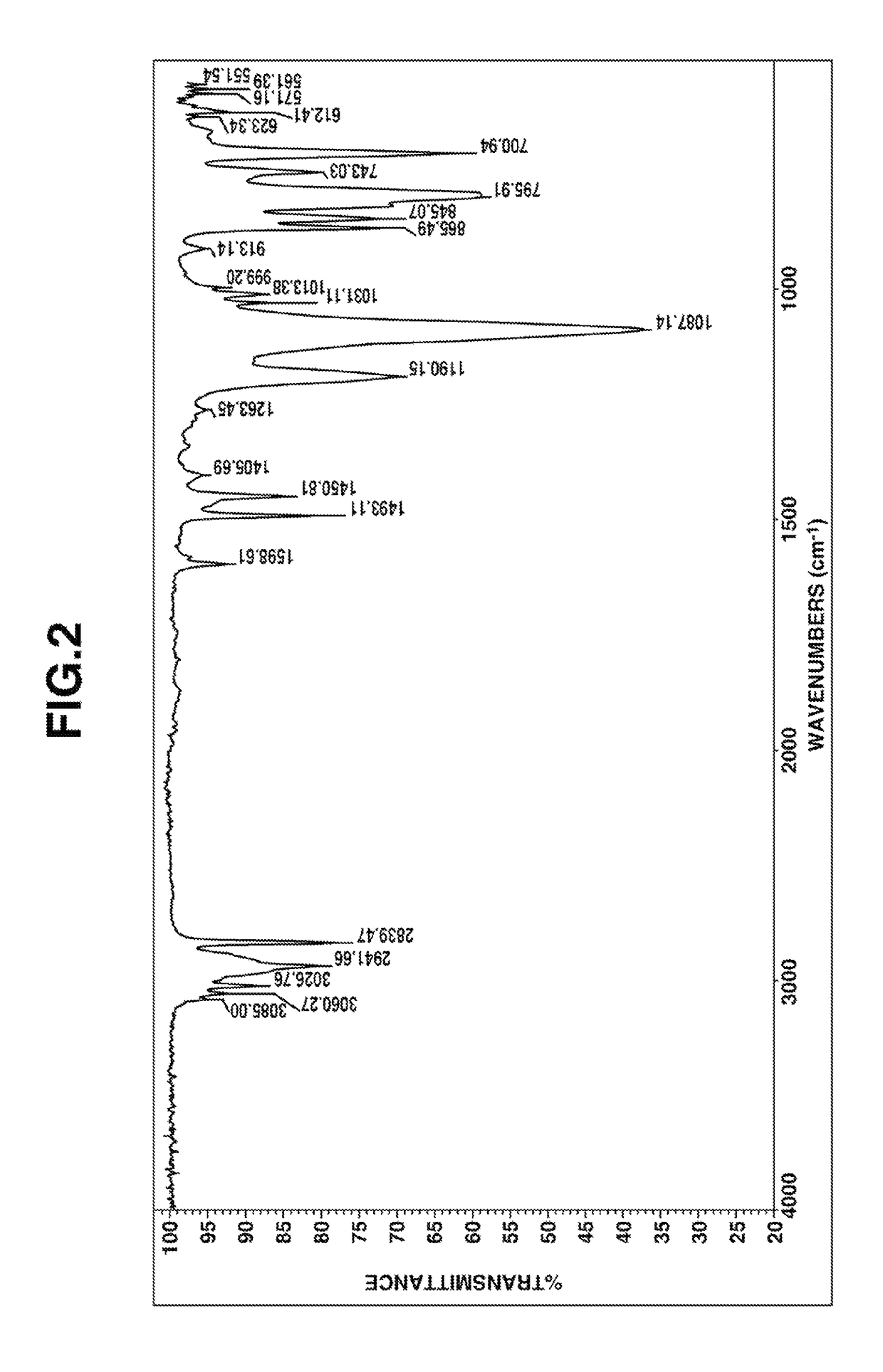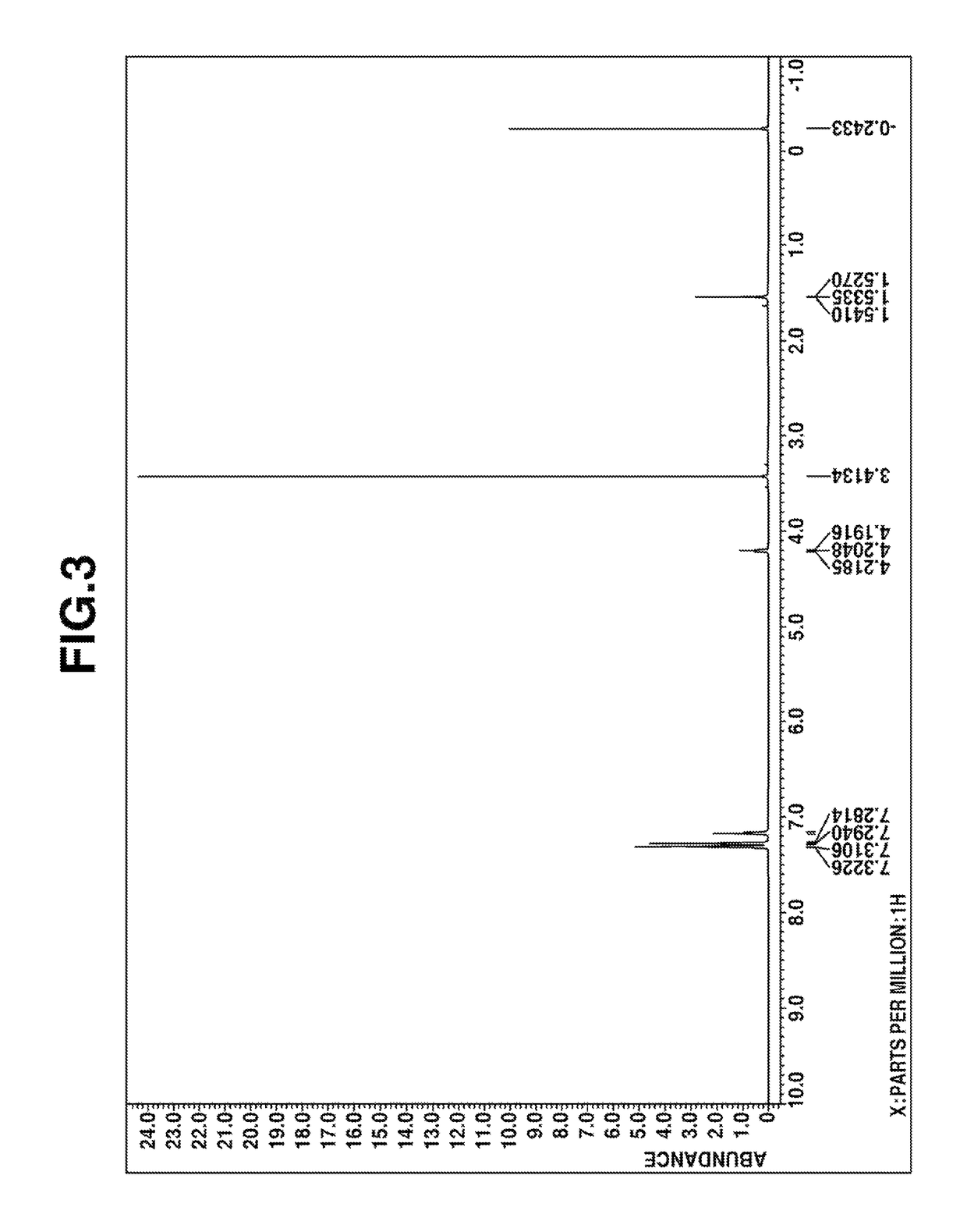Organosilicon compound having diphenylethyl and methoxysilyl and making method
a technology of organic compounds and diphenylethyl groups, which is applied in the field of organic compounds having diphenylethyl and methoxysilyl groups, can solve the problems of high corrosive hydrogen chloride, low affinity for active hydrogen-containing compounds, and low polarity of ethoxysilane compounds, so as to achieve easy hydrolysis, no hydrogen chloride, and high refractive index of the material
- Summary
- Abstract
- Description
- Claims
- Application Information
AI Technical Summary
Benefits of technology
Problems solved by technology
Method used
Image
Examples
example 1
Preparation of (2,2-diphenylethyl)trimethoxysilane
[0047]A flask equipped with a stirrer, reflux condenser, dropping funnel and thermometer was charged with 180 g (1.0 mol) of 1,1-diphenylethylene and an amount (1.0×10−4 mol of platinum per mol of 1,1-diphenylethylene) of a 2-ethylhexanol solution of chloroplatinic acid. To the flask, 136 g (1.0 mol) of trichlorosilane was added dropwise at an internal temperature of 80-90° C. over 8 hours. Stirring was continued for 1 hour at the temperature.
[0048]To the flask, 77 g (2.4 mol) of methanol was added dropwise at an internal temperature of 60-70° C. over 5 hours. The contents were stirred for 1 hour at the temperature, after which 86 g (0.85 mol) of triethylamine was added. Then 42 g (1.3 mol) of methanol was added dropwise at an internal temperature of 60-70° C. over 1 hour. Stirring was continued for 2 hours at the temperature, after which the reaction solution was filtrated to remove salts. To the filtrate, a methanol solution of sod...
example 2
Preparation of (2,2-diphenylethyl)methyldimethoxysilane
[0054]A flask equipped with a stirrer, reflux condenser, dropping funnel and thermometer was charged with 90 g (0.5 mol) of 1,1-diphenylethylene and an amount (1.0×10−4 mol of platinum per mol of 1,1-diphenylethylene) of a 2-ethylhexanol solution of chloroplatinic acid. To the flask, 58 g (0.5 mol) of methyldichlorosilane was added dropwise at an internal temperature of 60-70° C. over 8 hours. Stirring was continued for 1 hour at the temperature.
[0055]To the flask, 19 g (0.6 mol) of methanol was added dropwise at an internal temperature of 60-70° C. over 2 hours. The contents were stirred for 1 hour at the temperature, after which 56 g (0.55 mol) of triethylamine was added. Then 21 g (0.7 mol) of methanol was added dropwise at an internal temperature of 60-70° C. over 1 hour. Stirring was continued for 2 hours at the temperature, after which the reaction solution was filtrated to remove salts. To the filtrate, a methanol solutio...
example 3
Preparation of (2,2-diphenylethyl)dimethylmethoxysilane
[0061]A flask equipped with a stirrer, reflux condenser, dropping funnel and thermometer was charged with 90 g (0.5 mol) of 1,1-diphenylethylene and an amount (1.0×10−4 mol of platinum per mol of 1,1-diphenylethylene) of a 2-ethylhexanol solution of chloroplatinic acid. To the flask, 57 g (0.6 mol) of dimethylchlorosilane was added dropwise at an internal temperature of 80-90° C. over 12 hours. Stirring was continued for 1 hour at the temperature.
[0062]To the flask, 4 g (0.1 mol) of methanol was added dropwise at an internal temperature of 60-70° C. over 0.5 hours. The contents were stirred for 1 hour at the temperature, after which 71 g (0.7 mol) of triethylamine was added. Then 21 g (0.7 mol) of methanol was added dropwise at an internal temperature of 60-70° C. over 1 hour. Stirring was continued for 2 hours at the temperature, after which the reaction solution was filtrated to remove salts. To the filtrate, a methanol soluti...
PUM
| Property | Measurement | Unit |
|---|---|---|
| temperature | aaaaa | aaaaa |
| temperature | aaaaa | aaaaa |
| temperature | aaaaa | aaaaa |
Abstract
Description
Claims
Application Information
 Login to View More
Login to View More - R&D
- Intellectual Property
- Life Sciences
- Materials
- Tech Scout
- Unparalleled Data Quality
- Higher Quality Content
- 60% Fewer Hallucinations
Browse by: Latest US Patents, China's latest patents, Technical Efficacy Thesaurus, Application Domain, Technology Topic, Popular Technical Reports.
© 2025 PatSnap. All rights reserved.Legal|Privacy policy|Modern Slavery Act Transparency Statement|Sitemap|About US| Contact US: help@patsnap.com



